Seed Starting: Containers
You've picked out the varieties you want to grow. You ordered your seeds. Now you need to plant them! What type of containers or pots work best for seedlings? Let's examine a variety of seed starting systems. Then we'll look at the pros and cons. Hopefully this will guide you in selecting a growing system that works best in your situation.
How to Select the Right Seedling Pots
The first and more important thing to bear in mind is that when it comes to seed starting, there is no perfect, single solution. What's the best seed starting container? The answer to that question will depend upon the factors that are most important to you:
PLANT QUANTITY: The number of plants you plan on growing will have a huge impact on the growing system you decide to implement. For example, in a production environment like a greenhouse or nursery, you need to produce thousands of seedlings. To produce a high volume of seedlings, nurseries rely on systems that are compact and allow for smaller, denser plants.
PLANT SIZE: What if you are a small scale urban gardener who only grows a few peppers and tomatoes? You may benefit from a system that supports larger, more vigorous seedlings. Growing massive plants with well established root systems gives you a great head start on the growing season. Healthier plants are more disease and pest resistant too. So a seedling container that grows plants with larger root systems might be exactly what you need.

They take up lots of space, but I can grow HUGE seedlings in these self-watering pots!
UPFRONT COST: We only have so much money. Many gardeners look at growing food as a way to SAVE money (not spend more). Other gardening hobbyists have no problem dumping hundreds of dollars in a system that only generates a fraction of what they invested. But they don't care because it's something they love doing. Starting seeds can be super cheap or maybe a little more costly, depending on what method you choose. Some systems require an upfront investment that slowly pays for itself over a course of years. So we'll look at what each system has to offer.
RENEWABILITY: Some seed starting solutions may seem simple and affordable at first glance. But a few of these systems are designed in a way that you'll have to come back, year after year to buy them again and again. This is something worth considering. Would you prefer a reusable product that you can clean and use again next year?
Video: Seed Starting Containers:
10+ Ideas for Vegetable Gardening
What containers work best for seedlings? Let's examine a variety of seed starting systems!
Seedling Container Options:
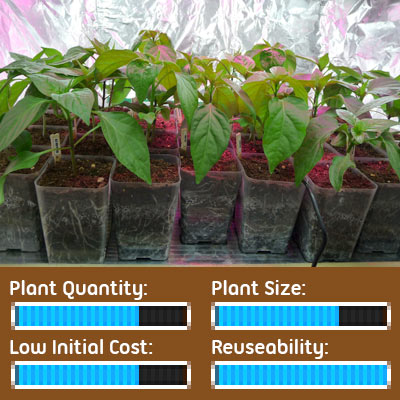
SEEDLING POTS: A simple, highly reliable method for starting seedlings is to just grow each one in its own individual pot. Opting for this method allows you to custom select the pot size and shape that best suits your needs.
It's so easy to mix and match your seedling containers. For standard sized plants like lettuce, I find that 2.25" square pots offer a nice balance of rooting size in a compact space. For larger plants like tomatoes, you can easily upgrade to 1 quart pots, allowing the plants to stretch out nicely. You can also select pots that have a more depth for better root systems.
Separate seedling pots allow you to scale up or down in plant size and plant quantity. Plants can be spaced out as they get bigger for better airflow. They can be easily irrigated from the bottom or even placed onto a watering mat. Such pots are easy to wash and reuse year after year. Of course, they may become hard to manage once you start juggling a very large quantity. So keep that in mind.
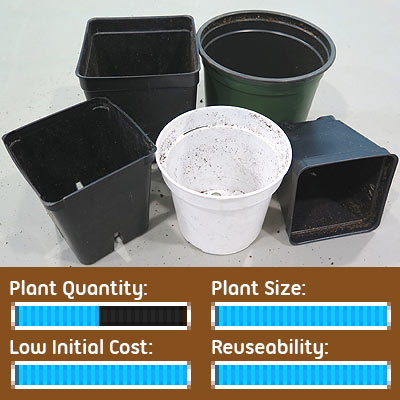
SALVAGED POTS: Have you ever bought a seedling or a small herb pot that came in its own little potting container? Hopefully you didn't throw the container away! I always hold onto mine. Time and again they have come in handy. Even if I just put a plant into one of these and then give it to a friend.
As your collection grows, you'll likely find that you have a stockpile of various sizes. That includes containers with extra depth for better root systems. Depending on the application, you can pick the pot size that is just big enough for whatever plant you're growing.
Reusing nursery pots makes a lot of sense. It saves you money. But it also diverts materials away from the landfill. I encourage people to recycle and reuse materials when practical. In the case of salvaged potting containers, it's a no brainer!

DRINKING CUPS / FOOD CONTAINERS: If you are brand new to gardening, you might not have many materials on hand. Starting from scratch can be daunting. And it can be quite costly. But it doesn't have to be that way. Recycling containers is a free way to acquire some seedling containers without spending a penny!
Why not rinse out some used party cups? Or you could clean some plastic food containers that are shaped properly for growing plants. I've used yogurt containers. Once clean, all you need to do is add some drain holes. I typically use a utility knife to cut triangular holes at the base.
To conserve potting mix and further save money, you don't actually need to fill the containers up all the way. This is especially true for less vigorous plants that don't have aggressive root systems. Even with larger plants like tomatoes, you could simply choose to plant them outside before they get oversized and become root bound.
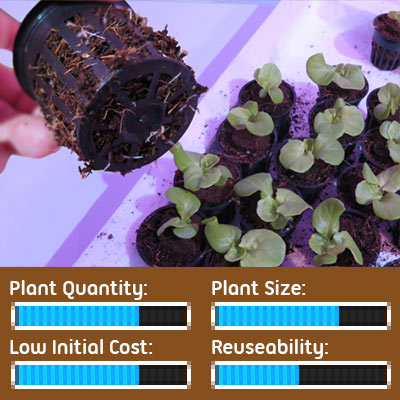
NET CUPS: Net cups were developed for use in hydroponics. These basket shaped cups have open slits in the sides and bottom. The openings allow plant roots to grow freely into rooting medium, nutrient solution or even into highly humid air!
Some people have found that net cups can be utilized in growing seedlings. In a standard growing environment, the roots grow to the sides and then stop as they hit dry air. This effect is called air pruning and it prevents unwanted circling of roots. The cups themselves can be placed onto a watering mat allowing them to draw up water as needed.
Net cups can be bought in bulk at a low price. The smaller cups are quite affordable, although they can be very flimsy. Larger cups would support larger plants and would also be easier to clean and re-use again.
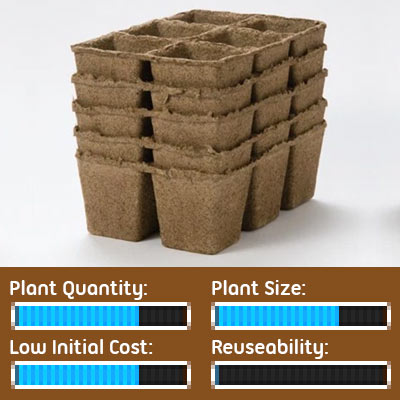
COW / PEAT / COIR POTS: Perhaps you've see square or round pots that have a texture similar to cardboard pulp. It's possible to find pots made from several biodegradable materials. Peat pots are made from peat moss. Coir or Coco pots are made from recycled coconut fiber. And CowPots are derived from composted cow manure. All of these are marketed with the intent that you can just plant the entire seedling into the ground and the pot will break down, allowing the seedling to grow to mature size.
Each of these materials has varying levels of sustainability. Some environmentalists oppose the use of peat moss for horticultural use due to the negative impacts of harvesting it. Coir is a more renewable alternative since it is a by-product of the coconut industry. Processing cow poo into a pot is also a cool way to utilize a resource that might otherwise be considered waste.
Some gardeners have complained that their biodegradable pot never properly decomposed during the growing season. If this happens, your plant may become root bound and its growth will be stunted. To avoid this, I peel away the pot and toss the pieces in the ground at planting time.
If your pot is kept moist and is breaking down quickly you may be just fine. One way to tell is to examine the outside edges of the pot before planting. Have plant roots begun to poke through the edges? These pots are meant to air prune the roots, preventing root spiralling. If you see tips of roots, then once you plant this in the ground, you know the roots will be ready to quickly spread out into the native soil. Growth will not be restricted and you should have good results. One final thought: these are consumable products. So you will be stuck buying new ones every year.

SEEDLING FLATS / CELL PACKS & TRAYS: Seedling flats offer tiny cells of soil for each plant. This high density system allows a lot of plants to be squeezed into a small space. Each flat is usually placed into an accompanying tray. The tray offers structure during transport. The trays also can hold excess water, keeping things neat.
Such systems are very common and cheap to implement. They devote only a small amount of potting media to any given plant. But seedling trays are most useful in a nursery or greenhouse application. They may not be the best solution in a small scale home environment.
In my personal experience, I've found the trays to be hard to water. Top irrigation works ok, but can be quite messy inside the home. I've tried lifting the flat and dumping water underneath into the tray. This bottom watering method is neater. But it's easy to over water. Also, some cells become over-saturated while seedlings on the edges may dry out faster. Root rot, fungus gnats and mildews can quickly follow. Using a system like this on a self-watering wicking mat can be a very helpful upgrade.

JIFFY PELLETS: Jiffy pellets are little compressed disks of peat moss (or sometimes coir) that expand when soaked in water. The pellets can take a while to absorb the water. But each one is a stand alone "pot" that comes with its own potting mix and nutrients. A simple solution for first time gardeners. Just add water and seeds!
As with a few other options out there, these also air prune the side roots. The squishy cylinder of potting mix is held together by a thin netting. Supposedly, plants roots can grow right through these, once planted in the ground. But some people have had issues with this. It might be safe to cut away the netting at planting time.
There are several sizes that will support various levels of plant size versus plant quantity. Of course, these are consumable products that you'll be stuck buying again and again. But you can buy packs of just pellets (refills) at a reasonable price. And remember: these save you from buying seed starting mix.
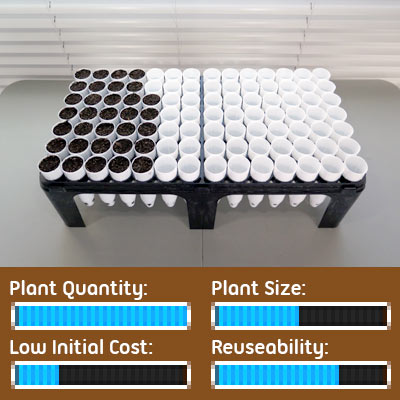
CONE-TAINERS / RAY LEACH TUBES:
Cone-tainers are a system developed by the forestry industry for a way of propagating young tree seedlings. These containers are very deep, allowing for a longer tap root. At the same time, they are narrow which works in a production environment where plant density is needed.
The cone-tainer system could certainly be used by a home gardener. But there are several things to consider. This system is has a somewhat limited availability. You may not find it in the typical big box stores or even in local garden centers. When purchased online, I've found them to be more expensive than common alternatives like flats and trays.
Cone-tainers require a stand for support. This makes them hard to handle in small batches. They are difficult to water from below. I like that you can pick up and move one or two cones as needed. But they are still cumbersome in small spaces. I recommend these for starting onions or leeks indoors from seed. You can grow lots of onions, while allowing for plenty of vertical root growth.

AIR-POTS: An Air-pot is a specially designed growing system built around one simple concept: air pruning of roots. These pots are shaped in such a way that they will guide roots along a channel that is cut open to the air. Once root tips reach the opening, they dry out and become "air pruned". The growth tip does not spiral. Instead it terminates. This results in more, branching roots being sent out from the plant.
Regular pots will result in a big ball of entangled roots. The larger the plant gets, the bigger the issue. Poorly watered plants tend to send out extra root growth, further worsening the problem. But plants grown in air-pots have a dense, fibrous network of feeder roots. At the outer edges, there is no entanglement. Instead, the roots are pointing outward, ready to resume growth once planted into the ground. Air-pots are TRUE air pruning systems in that the even air prune the bottom roots. Many systems cannot achieve this effect.
In particular, air-pots are great for growing healthy perennials like herbs and even trees. Perennials are permanent fixtures in your garden that you want to keep for many years. But planting a root bound tree in the ground gives it a horrible start in life. It stunts plants and ultimately leads to increased death rates.
Air-pots are a more costly growth system, especially when compared to other seed starting solutions. But they offer a small pot that is about a quart in capacity, and not as expensive. So you could use this for your larger seedlings that will be allowed to mature quite a bit before planting outdoors.
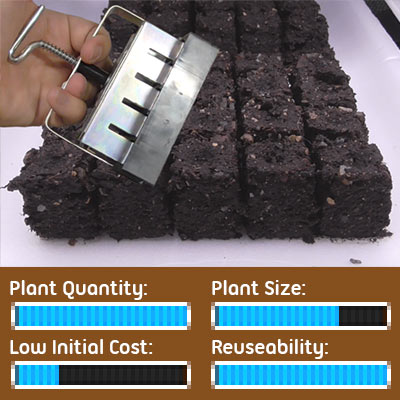
SOIL BLOCKERS:
Soil blockers are a pretty unique idea. They compress a special soil mix that forms small blocks or cubes of soil for your seedlings to take root. Each blocker has several squares allowing you to press out multiple blocks with each action. There is a tiny air space separating them, much like ice cubes in an ice cube tray. Ideally you would have a tray that you press them onto and then leave them in place.
The soil blocker system offers small, medium and large blocks. So you can start a large volume of seedlings. But you can also upgrade the blocks by fitting them into large blocks as plants get bigger. These cubes o' dirt need to be kept moist. I recommend placing them onto a capillary mat to supply water from underneath.
Soil blockers are a little more costly up front. But they are a truly sustainable system that will last for a long time. There is no waste. No containers to store. And as an added bonus, plant roots are air pruned on the sides, preventing the plant becoming root-bound.
I've never personally grown seedlings in these. I imagine it could be tricky to move these around in a small grow chamber. Rearranging plants might be a pain. I also can't imagine offering these plants to friends without first finding a way to protect the blocks from being squished or drying out. If you have a physical limitation, like arthritis, using these for a large volume of plants might be difficult. Otherwise, these seem rather ingenious and they just might fit your needs perfectly.
ALBO-STEIN SELF-WATERING SIP: This system is a little bonus that I wanted to throw in there. Each of these is constructed from a Clorox wipes container with a yogurt container nested into it. It's built on the same idea as using repurposed or upcycled containers for growing plants. But this system take things much further!
Each albo-stein holds 1 quart of potting mix. But it also has a self-contained water reservoir that can store 3 cups of water. This water slowly wicks up, through the use of a cord. As the seedling grows, water gets drawn up through capillary forces. It makes it super easy to water some very big seedlings.
These containers are fairly large and so you can't fit a lot of them into a small space. But these are a great way for a small scale urban gardener to grow some huge pepper or tomato seedlings, without having them dry out as they get big. I have a complete write up on these if you'd like to know more. Perhaps this design could be used with other containers that you encounter in your daily life.
← Seeds: Buying Heirlooms vs Hybrids
Big Seedlings: Grown in an Albo-stein →
Damping Off & Soil Sterilization →

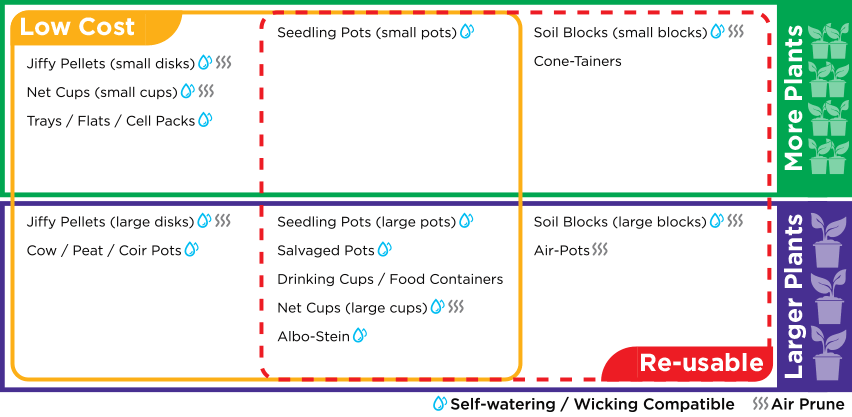



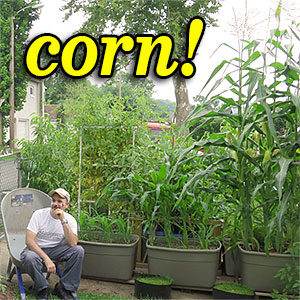
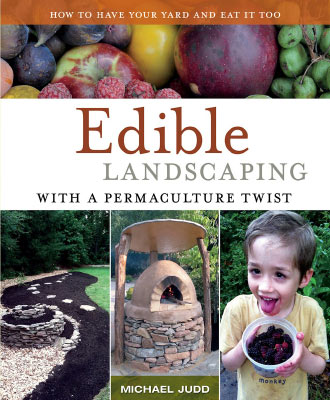
![ORGANIC Garden Produce [Gardening T-Shirt Design] ORGANIC Garden Produce [Gardening T-Shirt Design]](images/ORGANIC-Garden-Produce_Gardening-Tshirt-Spreadshirt.jpg)
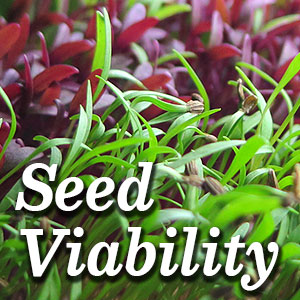
![Pre-Industrial Revolution CLIMATE CONTROL [Gardening T-Shirt Design] Pre-Industrial Revolution CLIMATE CONTROL [Gardening T-Shirt Design]](images/Pre-Industrial-Revolution-CLIMATE-CONTROL-carbon-sequestering_Gardening-Tshirt-Spreadshirt.jpg)